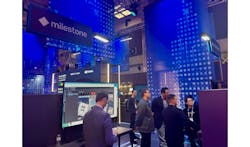Milestone Advances AI Strategy With Generative Plug-In for XProtect
Milestone Systems is introducing a generative AI-powered plug-in for its XProtect video management software (VMS), a move the company says represents the next step in how operators manage and learn from visual data.
Developed in collaboration with NVIDIA, the new tool is designed to automate video review, reduce false alarms and streamline operator workflows, signaling a broader evolution in Milestone’s technology strategy. A beta version is debuting at Smart City Expo World Congress in Barcelona, Nov. 4-6, with general availability coming later this year.
SecurityInfoWatch held an exclusive interview with Andrew Burnett, Interim CTO, and Edward Mauser, Director and Product Lead for Hafnia at Milestone Systems, to discuss the company’s new generative AI plug-in and what it signals for the future of video management.
Beyond traditional VMS
While Milestone remains rooted in its video management platform, the company is clearly pushing beyond conventional definitions of VMS functionality.
“VMS is still at our core,” said Andrew Burnett, who noted that the platform has steadily evolved through recent additions such as cloud services, analytics solutions and the Hafnia vision language model (VLM). “It’s about taking VMS as a concept for our customers and partners and bringing that into the modern era,” he explained. “Generative AI plays a huge part in that… and we play a role as a trusted provider to bridge that gap for customers and partners.”
That gap, Burnett said, includes the challenge of helping organizations engage responsibly with AI in ways that are both compliant and ethical. The company’s new plug-in is intended to provide that assurance while expanding the value of XProtect for operators and integrators alike.
Generative AI vs. traditional analytics
According to Mauser, the new approach relies on a vision language model that understands scenes in full context rather than focusing on isolated events or objects.
“A visual language model is trained on a very large amount of data that understands the context of the world better than a conventional model used on devices today,” he said. “This solution actually builds on and amplifies existing analytics to support use cases that previously couldn’t be solved without heavy investments.”
By integrating this model directly with XProtect’s rule engine, Milestone aims to simplify deployment while enhancing performance. Mauser said setup is straightforward, requiring only a few minutes to install, with no additional infrastructure or GPUs needed since the VLM operates as a service.
Key Capabilities of Milestone’s Generative AI Plug-In
-
Automated Incident Reports
Instantly converts selected video clips into structured, natural-language summaries, reducing the time operators spend on documentation. -
Event Validation
Analyzes motion events and verifies alarms in real time, filtering out false positives through full integration with the XProtect rule engine. -
Contextual Bookmark Summaries
Automatically generates text-based overviews of bookmarked footage for faster triage without manual video review. -
Flexible Deployment
Can be run on-premises or in the cloud, allowing users to meet compliance requirements and scale as needed. -
Ethical and Compliant AI
Built on Milestone’s Hafnia Vision Language Model trained on 75,000 hours of ethically sourced, real-world video using NVIDIA Cosmos infrastructure.
Reducing operator fatigue
A key objective behind the plug-in is to lessen the burden on security operators who manage large volumes of alerts. Mauser said the company’s estimate of potentially reducing alarm fatigue by up to 30% is based on daily alert patterns per camera and per operator.
“When alerts can be automatically validated — whether an incident needs attention or can be ignored — it allows operators to focus their time and energy much more effectively,” he said.
The integration of contextual bookmark summaries and automated incident reporting further supports that goal. “An operator might tag an incident to review later,” Mauser explained. “With VLM integration, the system automatically captures the surrounding footage, interprets what’s happening, and tells the operator if it’s something that needs attention. It’s about improving efficiency without adding workload.”
Ethical AI and data governance
Milestone executives emphasized that the Hafnia VLM was developed using ethically sourced, real-world video from Europe and the United States, a central tenet of the company’s commitment to responsible technology.
“In the generative AI space, it’s fairly common to just scrape data off the internet,” Burnett said. “The problem with doing that is you can’t prove where you got it from. It’s not traceable, it’s not compliantly sourced, and often you don’t have permission for it. We want to turn that on its head.”
He said Milestone’s approach involves obtaining properly licensed video data from customers, anonymizing it through the company’s acquisition of brighter AI, and ensuring it remains traceable and compliant under frameworks such as the EU AI Act and GDPR.
“Sometimes doing the right thing is a bit harder,” Burnett said. “But that’s where Hafnia was born. From the principle of sourcing and handling data responsibly.”
Mauser added that the company views this not just as compliance, but as part of a broader responsibility to “make the world a better place” by enabling organizations to future-proof their AI initiatives through traceability and transparency.
Expanding the ecosystem
In addition to the plug-in, Milestone is introducing VLM-as-a-Service, an API-based model that allows developers and partners to build their own generative AI solutions, even outside of XProtect.
“This isn’t about trying to steal a march in the marketplace,” Burnett said. “If we’re going to use it, others should be able to use it at the same time. We’re really excited about what innovation could come from our technology partners now that they have access to that.”
While the first applications center on traffic management, Burnett said the technology could have far-reaching impact. “If you’re improving traffic flow, you’re ensuring emergency vehicles can get through quicker, probably reducing accidents, and when they do happen, responders can act faster,” he said. “That’s where we think it starts — making cities safer — and we’ll expand from there.”
Milestone is already fostering that expansion through a developer hackathon tied to its upcoming Developer Summit in Copenhagen, Nov. 10-11. “We have companies and individuals using our API right now to build things we don’t even know about yet,” Mauser said. “We’ll uncover some of those next week when we announce the winners.”
Channel enablement and the road ahead
For now, the focus remains on launching the plug-in within the XProtect environment and extending its reach through the API model. Burnett confirmed that broader interoperability is on the roadmap, though details are still being worked out.
“For system integrators, we want to make sure we’re the VMS of choice,” he said. “This is another way to demonstrate our investment in the future and why our VMS is the right choice.”
Mauser noted that the offering is designed to empower the channel. “We’re trying to enable integrators to deliver more value without needing data scientists or engineers,” he said. “They just need to know how to use an API. It shortens the value chain for them to bring new solutions to market.”
Although Milestone has not disclosed pricing or licensing details, Burnett said general availability is expected soon. “The announcement and the launch aren’t a million miles apart,” he said. “We’re pretty close.”
About the Author
Rodney Bosch
Editor-in-Chief/SecurityInfoWatch.com
Rodney Bosch is the Editor-in-Chief of SecurityInfoWatch.com. He has covered the security industry since 2006 for multiple major security publications. Reach him at [email protected].

